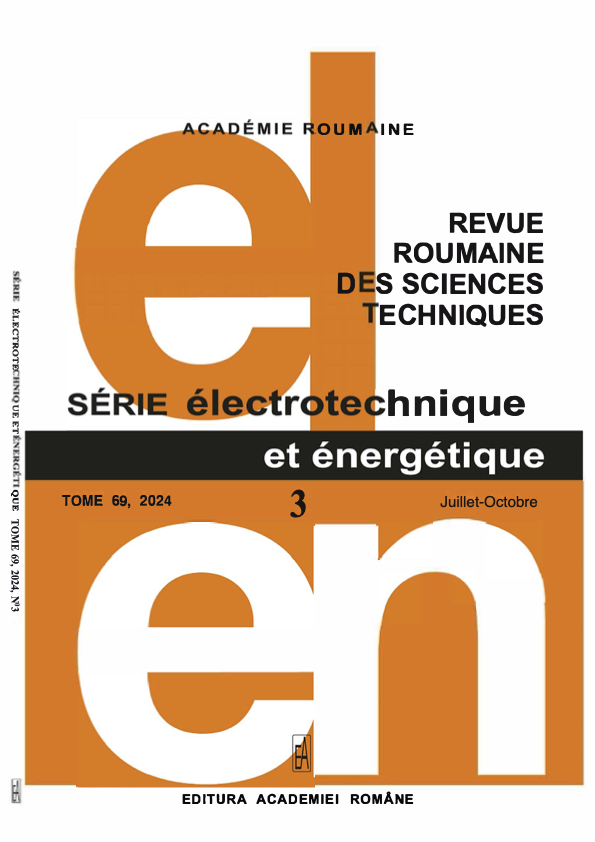RECOVERY OF NON-FERROUS PARTICLES FROM RECYCLING NEON LAMPS BY MAGNETIC INDUCTION SEPARATOR
DOI:
https://doi.org/10.59277/RRST-EE.2024.69.3.4Keywords:
Induction, Lamps, Lorentz, Magnetic, Neon, Recycle, SeparatorAbstract
The use of lamps worldwide is rapidly increasing, and the number of broken, burned-out, and defective lamps is very significant, polluting the environment. For this reason, we will address the topic of lamp recycling using magnetic induction technology. This paper presents induction separation by an innovative, improved induction separator design with an important advantage. It extracts aluminum particles from a mixture of waste materials, including non-metallic and non-ferrous particles from broken neon lamps. The induction separator features a single vertical disk rotated by an electric motor. The disk has a series of permanent magnets mounted alternately on its surface. The experimental results of the separation process achieved through an induction separator exhibit a high purity level, boasting a 100% separation efficiency, surpassing the performance of previous separators. These findings substantiate the validity of employing the induction separator to recycle conductive materials.
References
(1) D. Gaitanelis, D. Logothetis, G. Perkoulidis, N. Moussiopoulos, Investigation and evaluation of methods for the reuse of glass from lamps recycling, J. of Cleaner Production, 172, 3, pp.1163–1168 (2018).
(2) D.M. Rahman, S. Pompidou, T. Alix, B. Laratte, A review of LED lamp recycling process from the 10 R strategy perspective, Sustainable Production and Consumption, 28, pp .1178–1191 (2021).
(3) C.J. Grigoropoulos, L.T. Doulos, S.C. Zerefos, A. Tsangrassoulis, P. Bhusal, Estimating the benefits of increasing the recycling rate of lamps from the domestic sector: Methodology, opportunities and case study, Waste Management, 10, 1, pp. 188–199 (2019).
(4) L. Benmamas, Y. Bouzidi, G. Houset, K. Nomenyo, K. Bru, M. Beaulieu, P. Leclere, L. Clerget, G. Lerondel, Selective separation of plastic LED lamp components using electrodynamic fragmentation for material recovery, Waste Management, 144, 4, pp. 210–220 (2022).
(5) R.S. York, J.R. Nagel, R.K. Rajamani, Eddy current separation for recovery of non-ferrous metallic particles: A comprehensive review, Minerals Engineering, 133, pp. 149–159 (2019).
(6) M. Lungu, P. Rem, Eddy-current separation of small non-ferrous particles by a single-disk separator with permanent magnets, IEEE Transactions on Magnetics, 39, 4, pp. 2062–2067 (2003).
(7) A.N.I. Ayad, A. Ayad, Y. Ramdani, Simulation of eddy current separation of gold particles from sands, International Journal of Engineering and Manufacturing (IJEM), 6, 5, pp. 30–37 (2016).
(8) A.N.I Ayad, M. Larab, H. Boudjella, F. Benhamida et al., Simulation of eddy current and repulsive force of non-ferrous particles in eddy current separator, Przeglad Elektrotechniczny, 95, 6, pp. 49–54 (2019).
(9) M. Ouili et al., A simultaneous separation of magnetic and conductive particles in a designed permanent magnet drum separator, 61, 1, pp. 137–155 (2019).
(10) I. Dobrin, D. Enache, G. Dumitru, M. Gutu, S. Zamfir, R. Pintea, Curved dipolar electromagnet, numerical modeling and design Rev. Roum. Sci. Techn.–Électrotechn. et Énerg., 67, 4, pp. 409–415 (2022).
(11) M. Ouili et al., Coupling of PSO and FE methods for electrical conductivity identification of materials used in eddy current Separator, 72, 2, pp.103–114 (2023).
(12) A.N.I Ayad, Etude et Réalisation d'un séparateur à induction électromagnétique, thesis, Djilali Liabes University Sidid Bel Abbes, Algeria (2017).
(13) N. Dholu, J.R. Nagel, D. Cohrs, R.K. Rajamani, Eddy current separation of non-ferrous metals using a variable-frequency electromagnet, KONA Powder and Particle Journal, 34, 12, pp. 1–7 (2016).
(14) N. Bin, Y. Yi, S. Zhicheng, W. Qiang, A. Abdelkader, A. Kamali, D. Montalvao, Effects of particle size on the separation efficiency in a rotary-drum eddy current separator, Powder Technology, 410, pp.1–35 (2022).
Downloads
Published
Issue
Section
License
Copyright (c) 2024 REVUE ROUMAINE DES SCIENCES TECHNIQUES — SÉRIE ÉLECTROTECHNIQUE ET ÉNERGÉTIQUE

This work is licensed under a Creative Commons Attribution-NonCommercial-NoDerivatives 4.0 International License.


